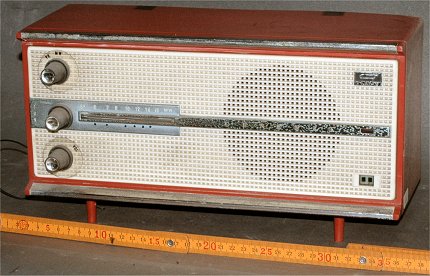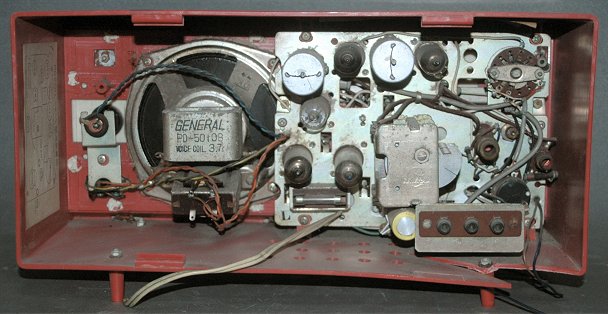

The Beginning of Stereo Broadcasting
1954-63
The beginning of Stereo Broadcasting
AM-AM Stereo Set
National Model SA-32 Stereo Amplifier Matsushita Electric Industrial Co., Ltd. 1962?
General Model MB201L/R Stereo Radio Yaou Radio Co., Ltd. 1962?
The Beginning of FM Stereo Broadcasting
Early FM Stereo Set
Trio Stereo AM-FM Tuner AF-220 Kasuga Radio Co., Ltd. 1959 JPY 18,200
Trio Stereo Amplifier Model AF-30 Kasuga Radio Co., Ltd. 1959-60 JPY 29,900
FM Stereo Adaptor National RD-511 Matsushita Electric Industrial Co., Ltd. 1963?
Star Multiplex Unit Model MU-34 Fuji Seisakusho Ltd. 1962?
Radio Phonograph HOME Radio Museum HOME
The Beginning of Stereo Broadcasting
After WWII, development of stereo broadcasting started.
First stereo broadcasting was AM-AM system. This system needed 2 AM stations
that had different frequencies.
Each left and right channel sent from each station. Listener set up 2 radio
set tuning each frequency.
In 1952, experimental stereo broadcasting started by NHK 1 and 2.
From 1954, frequent broadcasting started as “Stereo Music Hall”.
This broadcasting was earlier than first stereo LP record then it was first experience of stereo effect to ordinary listeners.
To receive AM-AM stereo, 2 radio set needed. Almost listeners did not have
same 2 radio sets.
In experimental era, early listeners set up different 2 radio sets.
It was not ideal, however, they could feel stereo effect.
After 1958, another AM-AM stereo broadcasting started by 2 tied up commercial
broadcasting stations in Tokyo.
AM-AM stereo tuners and stereo phonographs put on the market since 1958.
In 1963, experimental FM stereo broadcasting started by NHK.
AM-AM stereo broadcasting by NHK ended in 1964.
National Model SA-32 Stereo Amplifier 1962? Matsushita Electric Industrial Co., Ltd.
This was typical AM-AM stereo amplifier.
Circuit was very practical. Same 2 radio set was installed.
To avoid interference, each channel had different IF frequencies.
Matched record player and speaker was prepared.
(Collection No.46024)
General MB201L/R Stereo Radio Yaou Radio Co., Ltd. (1962?)

MB201L MB201R

TUBES: 12BE6-12BA6-12AV6-30A5-35W4, Permanent Dynamic
This is a set of 2 radios for AM-AM stereo broadcasting.
Front panels of these sets were designed symmetrical to use same parts.
Model L and R were sold separately.
Most of stereo radio were large sized Hi-Fi radio or radio phonograph.
Small stereo radio sets were rare.The cabinet of MOdel "L" was broken.
(Collection No.11447/11759)
FM broadcasting can stereo or multiple broadcasting.
Various format of stereo or multiple broadcasting were proposed in U.S.A.
FM Tokai, the first Japanese commercial experimental FM station interestead in SCA(Subsidiary Communication Authorization).
FM Tokai was educational broadcasting station by Tokai University.
They needed SCA to realise a coexsistence of educational and entertainment
program.
FM Tokai investigated FM-FM multiple broadcasting system (Crosby format).
The experimental broadcasting by Crosby format started from 1958 in U.S.A.
The main channel of this format was L+R, sub channel was L-R, sub career
was FM modulated 50kHz.
In 1960, multiplex adapter for Crosby format put on the market by Kasuga Radio Co., to receive FM Tokai’s experimental broadcasting.
In 1961, FCC (U.S.A.) determined FM stereo broadcasting format.
Winning format was proposed by GE and Zenith used 19kHz pilot tone signal to detect stereo signal.
The FM Tokai’s experimental broadcast by Crosby format was ended.
In 1962, BBC (U.K.) started experimental FM stereo broadcasting by GE-Zenith format.
In 1963, Japanese MPT (The ministry of Post and Telecommunications) adopted GE-Zenith format for FM stereo broadcasting without SCA.
From 24/12/1963, NHK-FM experimental station (Tokyo) started stereo broadcasting.
FM multiple broadcasting FM Tokai aimed did not realized.
FM Tokai started experimental FM broadcasting too.
In 01/03/1969, NHK-FM switched over regular broadcasting station from experimental station.
In 1970, FM Tokai changed company name into FM Tokyo and started regular stereo broadcasting.
In 1979, FM Tokyo tried to SCA, however this project ended only experiment.
FM Tokyo continued educational broadcasting.
In1998, educational program switched to satellite broadcasting (CS-PCM), and educational program by FM ended.
Trio Stereo AM-FM Tuner AF-220 Kasuga Radio Co., Ltd. 1959? JPY 18,200
TUBES: 2-12AT7 4-6BA6 6AU6 6BE6 6AL5 6X4
Early Stereo FM tuner. This set installed single AM and FM tuner.
At that time, AM-AM stereo broadcasting started and prepared experimental FM stereo broadcasting in Japan.
In U.S.A. AM-FM stereo broadcasting had been operated. This model matched with AM-FM stereo broadcasting.
This set needed other tuner to listening AM-AM or FM-FM stereo, and needed adapter to listening FM-multiplex stereo broadcasting.
The form of FM stereo broadcasting still not determined. These function was matched for such era.
The band of Japanese FM broadcasting was 80-90Mc.
In 1960, same designed AM-AM stereo tuner model AM-230 (JPY 14,900) put on the market.
Appeard on the magazine "Musen to Jikken"(The Radio Experimenter's Magagine) 08/1959 published by Seibundo-Shinkosha
(Collection No.47011)
Trio Stereo Amplifier Model AF-30 Kasuga Radio Co., Ltd. 1959-60年 JPY 29,900
TUBES: 2-12AT7 2-6BA6 6AL5 6BE6 6BD6 2-12AX7 4-6BM8(ECL82) 5AR4(GZ34) 1H3
Trio's hi-end stereo receiver. The form of FM stereo broadcasting still not determined.
This set matched for 5 forms of FM and AM broadcasting.
AM mono
FM mono
AM+AM(AUX):AM-AM stereo with external AM Tuner
FM-AM
FM multiplex Stereo(with external Adapter)
The band of Japanese FM broadcasting was 80-90Mc.
Power stage was 6BM8 p-p. Magic eye was 1H3. This tube used for portable radio.
Gold colored panel was targeted for American market.
Appeard on the magazine "Musen to Jikken"(The Radio Experimenter's Magagine) 09/1959 published by Seibundo-Shinkosha
(Collection No.46018)
FM Stereo Adaptor National Model RD-511 1963? Matsushita Electric Industrial Co., Ltd.
In 1960’s, FM stereo was operated as experimental broadcasting in the limited area.
Almost of stereo set with FM band did not have multiplex circuit.
To receive FM Multiplex stereo, listener needed adapter unit.
This model was Matsushita’s Stereo adapter unit.
The lamp of front panel was stereo indicator.
(Collection No.47013)
Star Multiplex Unit Model MU-34 1962? Fuji Seisakusho Ltd.
TUBE: 6EA8
In 1960’s, FM stereo was operated as experimental broadcasting in the limited area.
Almost of stereo set with FM band did not have multiplex circuit.
To receive FM Multiplex stereo, listener needed adapter unit.
This unit made for installed internally.
(Collection No.11040)
Radio Phonograph HOME Radio Museum HOME